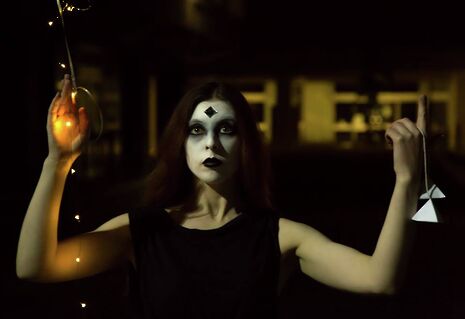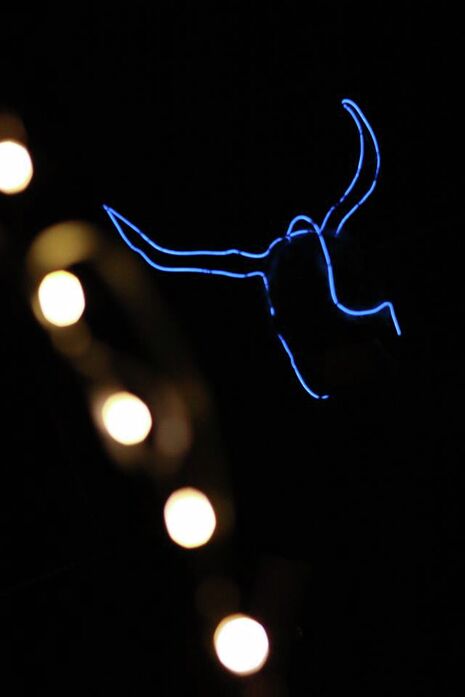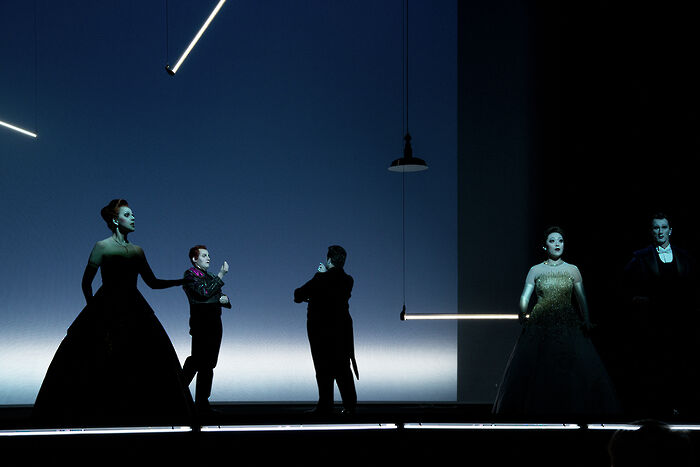Review: Asterion
A hypnotic piece of performance art, weaving dance and myth with an almost ritualistic precision

The Judith E. Wilson drama studio is dark, save for four trails of coloured light floating, wavering, marking the perimeters of the performance space. Slowly from the recesses of the room, something approaches. Its head is a neon-blue outline, horned and heavy. It drags its feet along the floor with an outstretched arm. Moving backwards and forwards, it marks methodical, maze-like lines through the gloom.
It emphasised the power of the unspoken
This was the second of eight scenes in Asterion – a “theatrical installation” performed for two nights this week. Mixing mythic references – such as Asterion, the minotaur above (Tom Stell), Ariadne (Gwen Davis) and Icarus – with fragments of texts and inspiration from Japanese noh dance-drama, it provided a meditative evening of fluid figures and frequently haunting images. At several points, performers sat in the shadows, moving paper pyramids or Greek letters, chanting quotations by writers such as Italo Calvino or from the London A-Z. At others, they engaged in flowing choreography, often seeming to merge with the half-light.

This staging provided the show’s greatest strength – its mesmerising uses of light, held in the palms of the performers; its iconographic imagery. In one particularly evocative moment, a blind Asterion was led around the stage by Ariadne, as she tried to get him to touch the lights hanging down. Such sights were allowed to linger. The use of darkness onstage only heightened the feeling that I was watching something both timeless and ritualistic. It emphasised the power of the unspoken.
This sense of the undefined and the inarticulable stayed with me more than any intended allusions or meaning. Though the audience was provided a set of explanatory notes from the director (Tom Stell) prior to the show, I was left wondering whether these were worth reading before such an impressionistic performance – or whether they were necessary at all.
Asterion seemed intended to meld disparate influences into coherence. The impressive choreography was inspired by the ways both noh theatre and the ancient Greek ‘Dance of the Cranes’ used the paths of their performers to draw the eye. Every action was apparently loaded with significance. The texts quoted were linked thematically, across time and geography. The result was similar to reading an imagist poem.
However, like imagist and other modernist work, I found that the resulting meaning was hard to decode in the moment. I ended up choosing to focus on the experience of the performance, rather than what it was trying to say.
Moreover, if the aim was to suggest cultural equivalencies or resonances across time, some of the texts used may have carried unintentionally negative implications. The first quotation came from Ezra Pound’s Canto V; one of the last was by colonial geographer William Hakluyt. Together, these might be read in ways which undermine what was intended.
Nevertheless, the installation was an atmospheric and often powerful piece of art. With its deft control of lighting and fluid use of space, Asterion breathed life into myth, in all its colour and its strangeness.
 News / Trinity exam burglar jailed for 11 months18 July 2025
News / Trinity exam burglar jailed for 11 months18 July 2025 News / Newnham students warned against using ‘secluded or concealed routes’ in evening after student followed16 July 2025
News / Newnham students warned against using ‘secluded or concealed routes’ in evening after student followed16 July 2025 Lifestyle / Seven species of Sidge17 July 2025
Lifestyle / Seven species of Sidge17 July 2025 News / Fenner’s cricket ground suffering ‘dismal decline,’ action group says 17 July 2025
News / Fenner’s cricket ground suffering ‘dismal decline,’ action group says 17 July 2025 Interviews / The Cambridge student hoping to become mayor of Baltimore: Thomas ‘TJ’ Jones16 July 2025
Interviews / The Cambridge student hoping to become mayor of Baltimore: Thomas ‘TJ’ Jones16 July 2025








